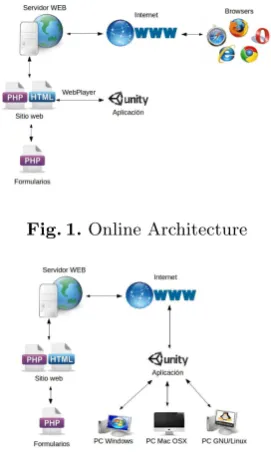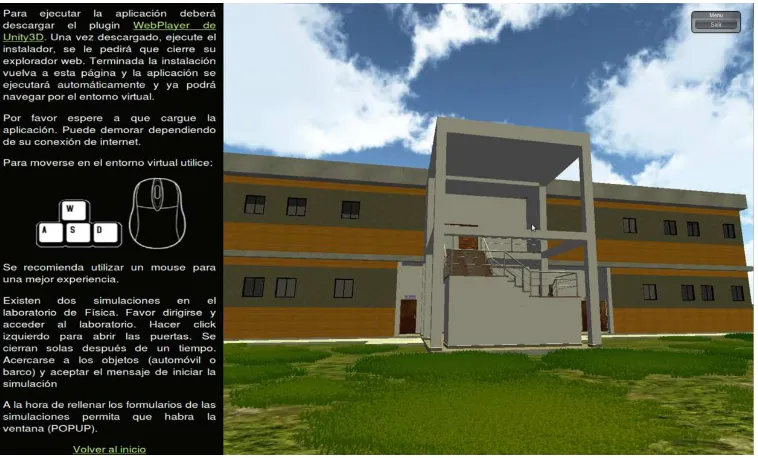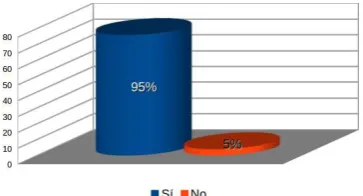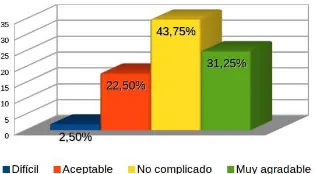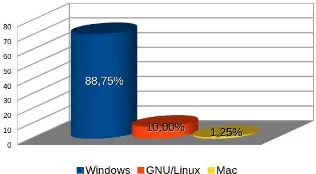Experience
Victor Obrist and Eustaquio Martnez
Polytechnic School, National University of the East Ciudad del Este, Paraguay
{victor.obrist,ealcidesmartinez}@gmail.com
Abstract. The project is an application that allows users to interact in a virtual environment via web interface, in which models are in three dimensions to simulate different activities. The application focuses on education through the use of virtual reality technology, enriching the student’s perception through the interaction with objects in an artificial world, facilitating their learning. For this purpose a website was built on which the application can be executed directly in the web browser with the help of a plugin or downloaded and run as a native application. The user navigates in the virtual environment containing a three-dimensional replica of one of the laboratories of the Polytechnic School U.N.E. The tests consisted of running the model and laboratory simulations. The results obtained from forms show that the use of virtual reality is valid, accepted and helps understanding the context of the simulations.
Keywords: Virtual Reality, Simulation, Computer Graphics.
1
Introduction
New information and communication technologies are emerging with the modern times, one of them is the Virtual Reality, which is widely used in areas of research, simulation, among others that deal with the use of computers for displaying information and give users new ways to make the most of it.
Using this advantage, Virtual Reality is gaining ground in education, getting students to interact and even manipulate information, having rich teaching and enabling the understanding of any area with ease, even the most technical.
1.1 Problematic
laboratories according to the needs, all in one location, with the assurance that if an equipment is damaged in the virtual laboratory, it can be replaced or fixed at the moment of the event, requiring only to restart that specific simulation.
A divergence of this kind of laboratory would use the Internet as a means of dissemination of the class, since having a location for simulation is being tied to schedules, leading the student to have to wait when is available for use after school’s hours.
The implementation of the application using Internet solve this problem, being able to have classes even at homes, students attend the simulation with the ”virtual” presence of the teacher, and if they have questions outside class time, could access it to better investigate, without having to wait for use. With the creation of these simulation and studies centers, teaching of abstract matters would be benefit, since the manipulation of parameters, changes involving them and their importance in the studied model could be perceived in a better way. Both students and teachers have at their disposal a powerful tool in education, particularly in vocational subjects in technical field.
2
Virtual Reality
Defining Virtual Reality (or simply VR), is difficult. There are probably as many definitions as there are researchers, as its recent and rapid evolution has not allowed a clear definition. Thus it not is surprising that the virtual reality turns out to be relative to different people and in different situations.
Some definitions to follow:
– Virtual reality is the experience of telepresence, where telepresence is the sense of presence using a means of communication.
– Virtual realityis a way by which human visualize, manipulate and interact with computers and extremely complex data.
– Virtual reality is three-dimensional interactive environments and simula-tions that reproduce real situasimula-tions.
– Virtual reality is a highly interactive environment where users partici-pate through the use of a computer in a virtually real world. It is a three-dimensional computer simulation in which the user is immersed so com-pletely that this reality, artificial origin, appears to be real.
Virtual reality is an interactive three-dimensional computer simulation in which the user feels inserted into an artificial environment, and perceived as real based on incentives over sensory organs [1].
The aim of Virtual Reality is to create an experience that makes the user feel that is immersed in a seemingly actual virtual world; to do this, it uses 3D graphics and sound that surrounds the scenes shown. The user acts like an observer, who moves through the virtual world using suitable devices, such as glasses or electronic gloves.
Virtual Reality exploits every image reproduction techniques and extends them, using them in the environment which the user can examine, manipulate and interact with the exhibits. A virtual world is a mathematical model that describes a ”three-dimensional space”, within this ”space” are contained objects that can represent anything from a simple geometric entity, such as a cube or a sphere, to a complex shape, such as it can be an architectural development, a new physical state of matter or the model of a genetic structure. It is ultimately a step beyond what would be the computer simulation, case really interactive simulation, dynamic and real-time system [2].
3
Virtual Reality in Education
The techniques of virtual reality (multisensory digital simulation) appear in the eyes of many experts as the definitive means of computer input in the processes of education and training. In this sense, education is one of the most promising areas of social use for the dissemination of this emerging medium of commu-nication and digital simulation, which can be considered a perfected form of multimedia.
Interactive multi-sensory techniques such as virtual reality, offer extraordi-nary possibilities in this regard. In fact, virtual reality coupled with advanced telecommunications network, allows to imagine a teaching environment in which it is possible to experience the presence of the teacher and other fellow students and exchange opinions and materials with them as if we were together without none of the participants have to move from where it previously found at the beginning of the class. In this new context, the traditional role of the teacher changes, no longer a mere transmitter of knowledge more or less valid, to become the instructor about students learning with the help of technology, which is what provides interactive resources learning [3].
Techniques related to virtual reality are very suitable for training in all dis-ciplines requiring skills, because they facilitate the realization of practices in all situations (including, especially, those that may be hazardous in the physical world). A basic development architecture of almost unlimited variety of virtual labs was developed. In them, scientists of many different disciplines are able to penetrate into previously unreachable horizons thanks to the possibility of being there: within a molecule, in the midst of a violent storm or in a distant galaxy [4].
3.1 AULA Nesplora
AULA is an assessment test that uses virtual reality to help diagnose the disor-der Attention Deficit / Hyperactivity Disordisor-der (ADHD) [5]. The AULA system analyzes the behavior of the child in a virtual school class. The test is initially perceived as a game, where you must perform a different task while typical distractions of a classroom are presented.
3.2 Labster. Virtual Biological Laboratory
Labster [6] is an international company dedicated to developing online tools for teaching science globally. Its main product is an easily scalable platform for online teaching of life sciences, which has been shown to significantly increase learning over traditional methods as well as substantially reduce costs [6].
The Labster platform is a 3D virtual learning environment based on a Virtual Laboratory. It Includes 3D animations molecules, questionnaires and support theory that invites the student to an immersive multimedia experience.
4
Method
4.1 Architecture
This work proposed, the development and implementation of an application that uses virtual reality technology as a support tool in teaching using a web interface. To achieve this objective a website with the following structure was created:
– Main Page:Contains a welcome and brief introduction about the project. Moreover there are available the download version of the application for different operating systems (Windows, Linux and Mac) the link to the ap-plication and a list of contact.
– Application: A page where the application of virtual reality lies with in-structions to use it.
– Simulation forms:Contains questions about the simulations in the appli-cation and the appliappli-cation itself. Used to collect data from usability, perfor-mance and compliance objectives.
– SQLite database: Stores data entered into forms for further processing.
In order to provide portability, the application has an online mode, which uses a supported Web browser with the Unity WebPlayer plugin. Both application and forms run on the user’s Web browser where an internet connection is necessary (see Fig. 1).
Fig. 1.Online Architecture
Fig. 2.Offline Architecture
The application development started with 3D modeling of the laboratory building based on photos using Blender 3D, once the modeling process was com-pleted, began the texturing of the photos taken as a reference, making the treat-ment and adjusting of the them to add to the model. The processing task and adjustment was conducted with the GIMP software. Finally the textured model was imported into the Unity 3D application for creating events and build ex-ecutables and Web version of the proposal, using the programming language C#.
4.2 Population
The population established close professional authors and students from the Polytechnic School - National University of the East - Paraguay first courses of Computer Sciencie Engineering, totaling 80 participants. Of this group 20 were professionals and 60 students.
5
Tests and results
5.1 Tests
experienced variation of the parameters, and with the results verified, algorithm settings where tuned to their optimal point. Tests were performed for Windows and GNU-Linux platform, both 64-bit, as they were available for use. Once this stage ended, testing with general public began.
[image:6.595.135.514.351.580.2]The website address,www.vuob.info/simvrwas spread through social net-works, email. The use of the application was entirely made by the user, without any assistance in addition to the existing instructions in the Web page. Besides disseminating to professionals, tests were conducted at the campus of the Poly-technic School - National University of the East, in one of the computer labs with groups of students from the Engineering Systems career with the help of the Teacher of the Physics matter. First, the demonstration and use of the appli-cation was proceeded, which was connected to the website from internet, showing the use of the application (3) with a real connection. Then the students used the application with the simulations prepared, with the support of the teacher and authors in case of doubt. Finally, via web forms for later analysis they were filled.
Fig. 3.3D Aplication on website
5.2 Results
The results obtained with the application are presented. They were extracted from the database and represent the values of the latter form, with respect to the application itself. Each of the indicators under study are detailed.
[image:7.595.214.403.287.385.2]Degree of Realism The model used in the application is a representation of the laboratory building of the Polytechnic School - National University of the East, being of great importance its resemblance to the actual building, as this aspect is one of the pillars of virtual reality. To do this, textures from photos were used. According to the results, the impact was positive, as in Figure 4 shows that 47.5% of participants responded with the highest note of the evaluation.
Fig. 4.Degree of Realism
Receipt of Virtual Reality technology The grade of reception of the user is studied with respect to using virtual reality applications. As shown in Figure 5, 95% of the respondents said that they are in favor of the use of this technology in applications.
[image:7.595.217.399.519.617.2]Learning using Virtual Reality The results on whether the virtual reality technology helped to some extent to the user better to understand the content presented in the simulations are shown below. As shown, 90% of respondents said that this technology provided some help in understanding the content (see Figure 6).
Fig. 6.Learning using Virtual Reality
[image:8.595.234.381.203.294.2]User Experience with the Application Among the features of virtual re-ality is the similarity of the movements people make in a virtual environment compared to those made in real life, facilitating their adaptation and immersion. Figure 7 shows that the application was well received and had more positive than negative with respect to its usability.
Fig. 7.User Experience
[image:8.595.227.384.449.536.2]Fig. 8.Speed application response
Portability As a study, the user is asked for his operating system, to demon-strate the application portability. As can be seen in Figure 9, the majority of users use Windows (88.75 %), including its variants: Windows XP, Windows Vista, Windows 7, Windows 8; It is one of the most used systems globally. But it’s not the only one, a small but significant percentage of users with GNU / Linux operating system represented by 10 % of the total and another group which is the 1.25 % who used the Mac OSX operating system is observed, which demonstrates the application portability.
Fig. 9.Application Portability
6
Conclusions and Future Work
The application developed in this work was successful, reaching the main objec-tive, which is to develop and implement a system that allows a user to interact with virtual scenarios in a learning environment.
6.1 Brief review of work
[image:9.595.228.386.383.470.2]Using the Blender application, the laboratory building of the Polytechnic School was modeled, including some furniture and equipment. For the physical appearance were taken pictures and then treated with the Gimp software. The model was exported to Unity3D and two simulations of physical phenomena, the oblique shot and uniform motion were created. With Unity3D the application to the different platforms mentioned above was exported.
In order to show the feasibility of the proposal, several tests with students of the institution and those outside it were made. They showed very satisfactory results about the use of virtual reality technology in conjunction with teaching.
6.2 Major Achievements
This work demonstrates the use of virtual reality in the learning environment. Considering the tests, the main achievements were clarified:
– Using virtual reality technology in a web and multiplatform environment.
– Representation with a high degree of fidelity of the laboratory building of the Polytechnic School - National University of the East.
– Running simulations of physical phenomena and positive feedback of results by students.
– Provide a support tool in the teaching-learning process.
6.3 Future Work
In view the possibilities with the use of virtual reality, it opens to research the following points:
– Development and implementation of a multi user module, enabling the use of avatars thereby enhancing the virtual experience.
– Application development for mobile platforms (Android, iOS, Windows Phone 8.1), extending architectures of execution.
– A comparison of the level of learning using the traditional method and using the application virtual reality.
References
1. Santelices Malfanti I. Parra M´arquez J.C., Garc´ıa Alvarado R. Introducci´on pr´actica a la realidad virtual. Eds. Universidad del B´ıo-B´ıo (2001)
2. Mart´ınez, J., Hilera, J. R., Ot´on, S. Aplicaci´on de la Realidad Virtual en la ense˜nanza a trav´es de Internet. http://pendientedemigracion.ucm.es/info/ multidoc/multidoc/revista/num8/hilera-oton.html
3. Diego Levis. Realidad Virtual y educaci´on. http://www.diegolevis.com.ar/ secciones/Articulos/master_eduvirtual.pdf
4. Realidad Virtual como m´etodo de entrenamiento. Realidad Virtual, http:// entrenamientovr.wordpress.com/realidad-virtual/
5. AULA. AULA,http://www.aulanesplora.com/
